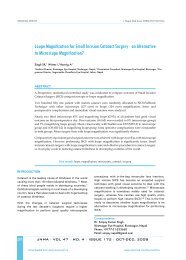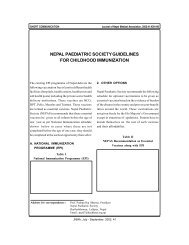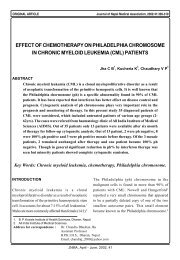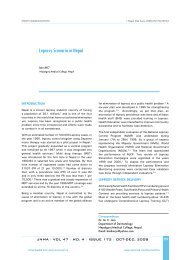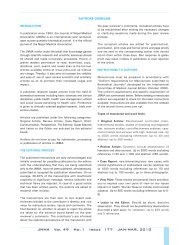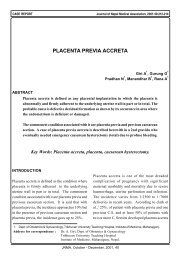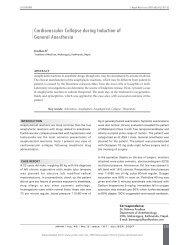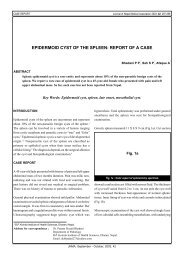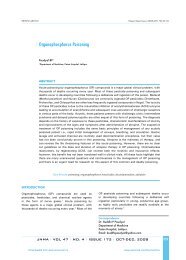Myths and Misconceptions about Abortion among Marginalized ...
Myths and Misconceptions about Abortion among Marginalized ...
Myths and Misconceptions about Abortion among Marginalized ...
You also want an ePaper? Increase the reach of your titles
YUMPU automatically turns print PDFs into web optimized ePapers that Google loves.
ORIGINAL ARTICLE J Nepal Med Assoc 2009;48(176):276-80<br />
<strong>Myths</strong> <strong>and</strong> <strong>Misconceptions</strong> <strong>about</strong> <strong>Abortion</strong> <strong>among</strong><br />
<strong>Marginalized</strong> Underserved Community<br />
Thapa K, 1 Karki Y, 2 Bista KP 3<br />
1<br />
Paropakar Maternity <strong>and</strong> Women's Hospital, Thapathali, Kathm<strong>and</strong>u, Nepal, 2 Health <strong>and</strong> Development, Nepal, 3 Family<br />
Planning Association of Nepal.<br />
ABSTRACT<br />
Introduction: Unsafe abortion remains a huge problem in Nepal even after legalization of abortion.<br />
Various myths <strong>and</strong> misconceptions persist which prompt women towards unsafe abortive practices.<br />
Methods: A qualitative study was conducted <strong>among</strong> different groups of women using focus group<br />
discussions <strong>and</strong> in depth interviews. Perception <strong>and</strong> underst<strong>and</strong>ing of the participants on abortion,<br />
methods <strong>and</strong> place of abortion were evaluated.<br />
Results: A number of misconceptions were prevalent like drinking vegetable <strong>and</strong> herbal juices, <strong>and</strong><br />
applying hot pot over the abdomen could abort pregnancy. However, many participants also believed<br />
that health care providers should be consulted for abortion.<br />
Conclusions: Although majority of the women knew that they should seek medical aid for abortion,<br />
they were still possessed with various misconceptions. Merely legalizing abortion services is not<br />
enough to reduce the burden of unsafe abortion. Focus has to be given on creating awareness <strong>and</strong><br />
proper advocacy in this issue.<br />
Key Words: abortion, legal abortion, misconceptions, myths<br />
INTRODUCTION<br />
Nepal’s parliament legalized abortion in March 2002 with<br />
a belief that access to legal abortion could significantly<br />
reduce maternal mortality <strong>and</strong> morbidity due to unsafe<br />
abortion. 1 Prior to it, abortion was equated with infanticide. 2<br />
The abortions that took place were mostly cl<strong>and</strong>estine<br />
unsafe abortions 3<br />
<strong>and</strong> a nationwide survey estimated<br />
that 20% of the women in Nepali Jails had been convicted<br />
on charges of abortion or infanticide. 4<br />
In 2006, the<br />
Maternal Mortality Ratio of Nepal showed to be 281<br />
deaths per 100,000 live birth. 5<br />
Deaths from abortionrelated<br />
complications accounted for over half of all<br />
maternal deaths in a hospital based study. 6<br />
Correspondence:<br />
Dr. Kusum Thapa<br />
Paropakar Maternity <strong>and</strong> Women's Hospital<br />
Thapathali, Kathm<strong>and</strong>u, Nepal.<br />
Email: kusumthapa2006@hotmail.com<br />
Phone: 9841555740<br />
276<br />
JNMA I Vol 48 I No. 4 I Issue I176 I Oct-Dec, 2009
Thapa et al. <strong>Myths</strong> <strong>and</strong> <strong>Misconceptions</strong> <strong>about</strong> <strong>Abortion</strong> <strong>among</strong> <strong>Marginalized</strong> Underserved Community<br />
However, low level of awareness 7 <strong>about</strong> safe abortion,<br />
limited availability of safe abortion services, social stigmas<br />
<strong>and</strong> especially various myths <strong>and</strong> misconceptions may<br />
impact the utilization of safe abortion services in Nepal.<br />
Also, most Nepalese are Hindus <strong>and</strong> Buddhists <strong>and</strong> believe<br />
that life begins at conception as soul takes form at<br />
conception thus feticide is a major sin. 8<br />
The study aims to reveal the underst<strong>and</strong>ing of abortion<br />
in Nepal <strong>among</strong> marginalized, underserved community<br />
people as they are more likely to be uneducated <strong>and</strong> opt<br />
for unsafe abortion. 7<br />
METHODS<br />
A qualitative study using focus group discussions (FGDs)<br />
<strong>and</strong> in depth interviews (IDIs) was conducted from<br />
January to April in 2006 in six districts under Family<br />
Planning Association of Nepal’s (FPAN) Global<br />
Comprehensive <strong>Abortion</strong> Care project (GCACP) viz. Kailali,<br />
Kanchanpur, Palpa, Banke, IIam <strong>and</strong> Sarlahi. Nine different<br />
categories of women from marginalized, underserved<br />
communities were identified (Table 1). Nine FGD guidelines<br />
were prepared <strong>and</strong> pre-tested on women with similar<br />
characteristics <strong>and</strong> revised in Kathm<strong>and</strong>u. Altogether 18<br />
FGDs were planned, two for each group, three to four<br />
in each district. Six to eight participants were selected<br />
purposively for each FGD from GCAPC/FPAN’s list. FGDs<br />
were continued till saturation. The sessions were recorded<br />
<strong>and</strong> later transcribed in Nepali. The study findings are<br />
limited by the fact that only 13 FGDs could be conducted,<br />
no FGDs could be conducted with wives of men having<br />
sex with men (MSM) <strong>and</strong> female intravenous drug users<br />
(IDUs) <strong>and</strong> only one was conducted with women with<br />
HIV as women did not consent to take part in the study.<br />
Sixteen categories of participants were identified for indepth<br />
interviews (IDIs) (Table 2) <strong>and</strong> two participants<br />
were chosen purposively for each, two to three from<br />
each district. Notes were taken during the interview by<br />
the interviewer.<br />
Table 2. Categories of participants identified for IDIs <strong>and</strong><br />
district wise distribution<br />
SN Participants (N=16) District N<br />
1. NGO service providers Kailali <strong>and</strong> Banke 2<br />
2. Trained birth attendants Kanchanpur <strong>and</strong> Banke 2<br />
3. Traditional birth attendants Kailali <strong>and</strong> Sarlahi 2<br />
4. FCHV Palpa <strong>and</strong> Ilam 2<br />
5. Private chemists Kanchanpur <strong>and</strong> Palpa 2<br />
6. Community leaders (male) Kailali <strong>and</strong> Ilam 2<br />
7. Community leaders (females) Banke <strong>and</strong> Sarlahi 2<br />
8. School teachers Kachanpur <strong>and</strong> Palpa 2<br />
9. Religious teachers Banke <strong>and</strong> Palpa 2<br />
10. Political leaders Kanchanpur <strong>and</strong> Ilam 2<br />
11. Lawyers Banke <strong>and</strong> Ilam 2<br />
12. Police Kailali <strong>and</strong> Sarlahi 2<br />
13. Married youth Kanchanpur <strong>and</strong> Sarlahi 2<br />
14. Married adolescents Banke <strong>and</strong> Sarlahi 2<br />
15. Unmarried youth Palpa <strong>and</strong> Ilam 2<br />
16. Unmarried adolescents Kailali <strong>and</strong> Sarlahi 2<br />
Total 32<br />
Informed consent of all study participants was obtained<br />
verbally prior to requesting them to participate in the<br />
study. Complete confidentiality was ensured. To maintain<br />
confidentiality, the real names have been substituted<br />
with other names while quoting. The information collected<br />
was manually analyzed, critically reviewed <strong>and</strong> information<br />
collated to generate factual qualitative data <strong>and</strong> meaningful<br />
conclusions.<br />
The data were analyzed using Microsoft excel 2007.<br />
RESULTS<br />
A total of 117 participants (Mean age 31.9, SD = 9.08),<br />
35 in FGDs (Mean age 31.5, SD = 8.03), 32 in IDIs<br />
(33.1, SD = 11.49) took part in the study.<br />
K=Kailali, Kan=Kanchanpur, B=Banke, P=Palpa,<br />
S=Sarlahi, I=Ilam, NGO/CBO= Non-Governmental<br />
Organization/Community Based Organization.<br />
All the study participants knew that abortion meant rid<br />
of a fetus <strong>and</strong> most common word being the ”Bachcha<br />
Giraune” (Table 3). However, their underst<strong>and</strong>ing of<br />
circumstances <strong>and</strong> settings of abortion differed. Some<br />
said abortion as getting rid of an unwanted child or a<br />
contraceptive failure while other said it is a result of<br />
immoral deed usually at an early age.<br />
JNMA I Vol 48 I No. 4 I Issue I176 I Oct-Dec, 2009 277
Thapa et al. <strong>Myths</strong> <strong>and</strong> <strong>Misconceptions</strong> <strong>about</strong> <strong>Abortion</strong> <strong>among</strong> <strong>Marginalized</strong> Underserved Community<br />
unsafe <strong>and</strong> could cause problems such as perforation of<br />
uterus, prolapsed uterus, heavy bleeding, infertility, <strong>and</strong><br />
even death. They said that crude unsafe methods were<br />
practiced in the past because abortion service was not<br />
legal <strong>and</strong> available in government health facilities. However,<br />
they said that they could not rule out that such crude<br />
methods of abortion are not practiced anymore.<br />
Majority believed that abortion is not safe at home <strong>and</strong><br />
they need to seek hospital service. At a hospital they<br />
(medical persons) take responsibility, it is safe <strong>and</strong> good<br />
<strong>and</strong> mother will not die.<br />
The main source of information on abortion were radio,<br />
newspapers, books, family relatives, neighbours, television,<br />
health centres <strong>and</strong> female community health volunteers<br />
(FCHVs).<br />
Majority knew that legal abortion can be done within three<br />
months of pregnancy, but surprisingly some said that they<br />
preferred home <strong>and</strong> told that only after three months<br />
woman should go to a hospital or clinic (Table 5).<br />
Table 5. Duration for legal abortion<br />
Women mentioned medical abortion, traditional/herbal<br />
methods of abortion <strong>and</strong> health institution based abortion<br />
as different methods of abortion (Table 4).<br />
Any woman needing advice <strong>and</strong> service on abortion sought<br />
advice from FCHV, close relatives such as sisters-in-law<br />
<strong>and</strong> other senior women in the community (Table 6).<br />
Table 6. Source of advice <strong>and</strong> service for abortion<br />
Many women believed <strong>and</strong> practiced measures like<br />
drinking juice extracted by squeezing leaves of banana,<br />
roots of lime tree <strong>and</strong> peppermint or using vegetables<br />
(Kupindo- pumpkin like fruit), lentils (Gahat), chillies,<br />
contraceptive pills (gulaf), honey, sugarcane molasses<br />
(gur), chuk (sour stuff), gudpak (sweets), grinded bamboo<br />
leaves in lukewarm water, putting cow dung <strong>and</strong> herbs<br />
into the uterus for abortion. Putting a heated clay pot<br />
on or pressing stomach with stones, tying a rope tightly<br />
around the abdomen, taking medicine for headache <strong>and</strong><br />
fever were also mentioned. Some women believed taking<br />
raw vermilion (kancho sindhur) causes abortion <strong>and</strong> also<br />
helps stop bleeding. They also said some women seek<br />
help of Guruba (Tharu traditional healer) <strong>and</strong> dhami/jhankri<br />
(witch doctor), who use herbal medicines to abort.<br />
The barriers to safe abortion were poverty, disagreement<br />
with family members, belief that abortion is a sin, health<br />
risk of abortion procedure, possibility of uterus problem,<br />
social ostracism, <strong>and</strong> embarrassment, lack of awareness<br />
<strong>and</strong> lack of privacy (Table 7).<br />
Table 7. Barriers to safe abortion<br />
Some believed that tablets found in Rupediya cost 300;<br />
five tablets can be bought, one big <strong>and</strong> four small. It is<br />
secretive <strong>and</strong> abortion can be done at home. Others<br />
asked help from traditional birth attendants (TBA). Some<br />
women did it by themselves.<br />
However, a big group of women believed that the above<br />
mentioned methods were crude, didn’t help much, were<br />
JNMA I Vol 48 I No. 4 I Issue I176 I Oct-Dec, 2009
Thapa et al. <strong>Myths</strong> <strong>and</strong> <strong>Misconceptions</strong> <strong>about</strong> <strong>Abortion</strong> <strong>among</strong> <strong>Marginalized</strong> Underserved Community<br />
The participants mentioned the qualities they look for in<br />
a health centre if they have to get abortion viz. safe<br />
service, cheap service, near, privacy, trained doctor,<br />
good treatment of clients by health providers, <strong>and</strong><br />
government listed site (Table 8).<br />
Table 8. Qualities of a service centre<br />
Many study participants approve of aborting an unwanted<br />
pregnancy but still there are certain sections of the<br />
society which do not do so. They think it is a sin to have<br />
abortion. The community leaders hold this view. This<br />
can affect innocent women who end up in unwanted<br />
pregnancy due to forced sex by husb<strong>and</strong>s or partner or<br />
failure of contraceptive methods. Proper education<br />
programme is needed to address this aspect of abortion.<br />
Many women justified abortion if it was meant to reduce<br />
family size or if it was a result of rape. This is justifiable<br />
but abortion is not the best solution. First <strong>and</strong> foremost,<br />
the cause of such unintended pregnancies should be<br />
controlled.<br />
DISCUSSION<br />
The accessibility to safe abortion has definitely increased<br />
with its legalization. Previously, only a very small proportion<br />
of women living in urban or semi-urban areas <strong>and</strong> able<br />
to afford the cost, had access to trained medical<br />
practitioners <strong>and</strong> safe procedures. 3 But the burden of<br />
unsafe abortions is still very high. Every year, an estimated<br />
19 million unsafe abortions occur worldwide, resulting<br />
in the deaths of <strong>about</strong> 70,000 women. 9 Unsafe abortion<br />
remains a major cause of maternal death in most<br />
developing countries. 10-14<br />
However, lack of knowledge <strong>about</strong> safe abortion, myths,<br />
misconceptions, poverty, <strong>and</strong> lack of privacy <strong>and</strong> fear<br />
of social ostracism act as barriers to utilization of safe<br />
abortion services.<br />
The terms “garvapatan” or “bhrunhatya” used for abortion<br />
which mean ‘destruction of pregnancy’ <strong>and</strong> ‘killing of an<br />
embryo’ respectively have negative connotations. Local<br />
terms such as “garva tuhaune”, “bachcha nikalne” (taking<br />
the baby out from the womb), “tuhaunu” (expelling) or<br />
“adhigro phalne” (getting rid of half grown foetus) also<br />
convey negative meaning. In order to promote induced<br />
abortion positively there is a need to chose less harsh<br />
terms for abortion.<br />
Several myths <strong>and</strong> misconceptions are tied with abortion.<br />
Many women try out different herbs <strong>and</strong> crude methods<br />
of abortion which put them in a dangerous situation.<br />
Poverty leading to un-affordability of abortion service<br />
<strong>and</strong> social stigma attached to abortion make women<br />
seek age old crude methods of abortion. Eating inedible<br />
things, inflicting physical pain could be extremely harmful<br />
to the women. There is a need to educate the target<br />
audience that old ways are seriously harmful.<br />
Since the legalization of abortion <strong>and</strong> expansion of<br />
abortion service to different parts of the country, women<br />
in general appear to take it as a common practice. Still<br />
many women do not freely share that they have had<br />
abortion although it is quite clear that with increasing<br />
use of contraception <strong>and</strong> inevitable failure of some<br />
methods women end up with unwanted pregnancy <strong>and</strong><br />
seek abortion service.<br />
Women from different parts of the country <strong>and</strong> caste<br />
<strong>and</strong> ethnicity know <strong>about</strong> induced abortion. Most<br />
participants of the study knew that surgical abortion<br />
service is available in most parts of the country. However,<br />
most of them were of the view that abortion is a personal<br />
matter <strong>and</strong> they prefer to go to a place where<br />
confidentiality is highly maintained. That a woman has<br />
had abortion is kept highly confidential.<br />
Decision to abort is not necessarily made by the woman<br />
alone. It is made by husb<strong>and</strong> <strong>and</strong> or mother-in-law or<br />
jointly although it was also found that decision to get<br />
rid of unwanted pregnancy due to illicit relationship is<br />
primarily made by the woman alone <strong>and</strong> it is kept highly<br />
confidential.<br />
Although in the past abortion was a cl<strong>and</strong>estine affair<br />
<strong>and</strong> took place in a secret place including woman’s own<br />
home but nowadays most women prefer to go to a health<br />
institution for abortion. However, unwanted pregnancy<br />
due to rape, incest or illicit relationship is still tried to<br />
get aborted in secret. It is still difficult for such women<br />
to come out to a regular abortion service centre,<br />
programme need to address this aspect of abortion.<br />
Also cost of abortion apparently is an inhibiting factor<br />
for several women which compel them to seek cheap<br />
service. Women in border towns or villages seek cheap<br />
medical abortion <strong>and</strong> attempt to abort unwanted pregnancy<br />
at home which is subject to high risks.<br />
JNMA I Vol 48 I No. 4 I Issue I176 I Oct-Dec, 2009 279
Thapa et al. <strong>Myths</strong> <strong>and</strong> <strong>Misconceptions</strong> <strong>about</strong> <strong>Abortion</strong> <strong>among</strong> <strong>Marginalized</strong> Underserved Community<br />
Therefore there is an urgent need to look into the cost<br />
of abortion service <strong>and</strong> adopt ways to make abortion<br />
accessible to women from marginalized communities.<br />
Many study participants held the view that abortion is<br />
largely first trimester abortion <strong>and</strong> most of them seek<br />
abortion during the first three months of pregnancy. This<br />
is good <strong>and</strong> it should be strengthened as late time<br />
abortions are fraught with higher risks.<br />
CONCLUSIONS<br />
Despite various misconceptions, overall the study<br />
participants believed that health care providers should<br />
be consulted for abortion. This belief should be<br />
strengthened which calls for quality training to providers<br />
on abortion counselling including thorough knowledge<br />
<strong>about</strong> abortion law, competency in abortion procedure,<br />
infection prevention, post-abortion contraceptive<br />
counselling, follow-up <strong>and</strong> management for possible<br />
complications.<br />
REFERENCES<br />
1. Department of Health Services. Annual Report 2002/2003.<br />
Kathm<strong>and</strong>u: Ministry of Health <strong>and</strong> Population, Nepal; 2003.<br />
2. Shrestha GB. Muluki Ain: Ek tippani. 4 th ed. Kathm<strong>and</strong>u:<br />
Pairawi Publications; 2001. p. 578.<br />
3. Thapa S, Padhye SM. Induced abortion in urban Nepal. Int<br />
Fam Plan Perspect. 2001;27(3):144-7 & 151.<br />
4. Tamang AK, Puri M, Nepal B. Women in prison in Nepal for<br />
abortion. Kathm<strong>and</strong>u: Centre for Reproductive Law <strong>and</strong><br />
Policy <strong>and</strong> CREHPA; 2000.<br />
5. Ministry of Health <strong>and</strong> Population, New ERA, Macro<br />
International Inc. Nepal demographic <strong>and</strong> health survey 2006.<br />
Kathm<strong>and</strong>u <strong>and</strong> Calverton: Ministry of Health <strong>and</strong> Population,<br />
Nepal; New ERA; Macro International Inc.; 2007.<br />
6. Thapa PJ, Thapa S, Shrestha N. A hospital-based study of<br />
abortion in Nepal. Stud Fam Plann. 1992;23(5):311-8.<br />
7. Ministry of Health <strong>and</strong> Population, World Health<br />
Organization, Center for Research on Environment Health<br />
<strong>and</strong> Population Activities (CREHPA). Unsafe abortion: Nepal<br />
country profile. Kathm<strong>and</strong>u: MoHP, Government of Nepal;<br />
2006. p.24.<br />
8. Lipner JJ. The classical hindu view on abortion <strong>and</strong> the moral<br />
status of the unborn. In: Coward HG, Lipner JJ, Young KK,<br />
editors. Hindu ethics: purity, abortion <strong>and</strong> euthanasia. Albany:<br />
State University of New York Press; 1989. p.43.<br />
9. Grimes DA. Unsafe abortion: the silent scourge. Br Med Bull.<br />
2003;67:99-113.<br />
10. Ganatra B, Johnston HB. Reducing abortion-related mortality<br />
in south Asia: a review of constraints <strong>and</strong> a road map for<br />
change. J Am Med Womens Assoc. 2002;57:159–64.<br />
11. Olatunji AO, Sule-Odu AO. Maternal mortality at Sagamu,<br />
Nigeria--a ten year review (1988–1997). Niger Postgrad Med<br />
J. 2001;8:12–5.<br />
12. Verma K, Thomas A, Sharma A, Dhar A, Bhambri V. Maternal<br />
mortality in rural India: a hospital based, 10 year retrospective<br />
analysis. J Obstet Gynaecol Res. 2001;27:183–7.<br />
13. Granja AC, Machungo F, Gomes A, Bergstrom S. Adolescent<br />
maternal mortality in Mozambique. J Adolesc Health.<br />
2001;28:303–6.<br />
14. Fawole AA, Aboyeji AP. Complications from unsafe abortion:<br />
presentations at Ilorin, Nigeria. Niger J Med. 2002;11:77–80.<br />
280<br />
JNMA I Vol 48 I No. 4 I Issue I176 I Oct-Dec, 2009



